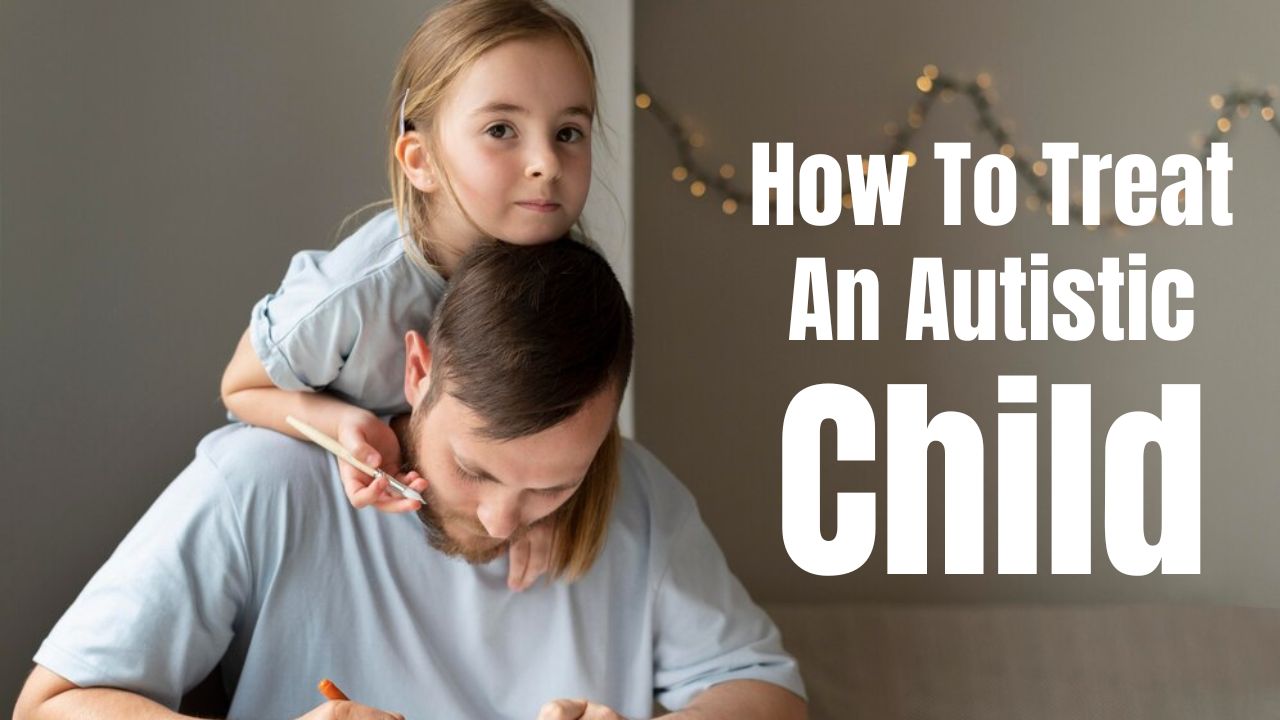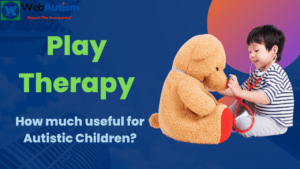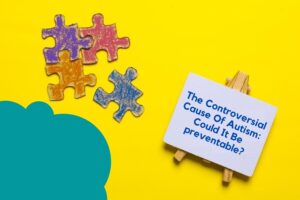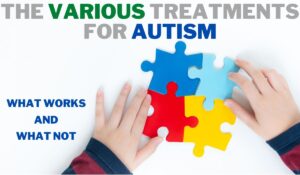Treating a child with autism involves a comprehensive approach that addresses various aspects of their development, communication, behavior, and overall well-being. Here are key strategies and interventions commonly used in treating children with autism:
1. Early Intervention
Early intervention is critical in treating children with autism spectrum disorder (ASD) as it focuses on identifying and addressing developmental delays, promoting learning and communication skills, and supporting overall development during the crucial early years of life. Here are key components and strategies of early intervention for children with autism:

- Early Screening and Diagnosis: Conduct early screenings and assessments for autism spectrum disorder (ASD) to identify developmental concerns and initiate intervention services as soon as possible. Early diagnosis allows for early intervention and support.
- Individualized Treatment Plan: Develop an individualized treatment plan based on the child’s strengths, challenges, developmental level, and family priorities. Collaborate with healthcare professionals, educators, therapists, and caregivers to create a comprehensive and tailored approach to intervention.
- Applied Behavior Analysis (ABA): ABA is a well-established intervention for children with autism. Early ABA intervention focuses on teaching functional skills, reducing challenging behaviors, promoting communication, and enhancing social interaction through structured teaching methods, positive reinforcement, and behavior management techniques.
- Speech and Language Therapy: Early speech and language therapy addresses communication challenges and delays in children with autism. Speech therapists use evidence-based practices to improve speech clarity, language comprehension, expressive language skills, social communication, and nonverbal communication.
- Occupational Therapy (OT): Occupational therapists play a vital role in early intervention by addressing sensory processing differences, fine motor skills, self-care skills, play skills, and adaptive behaviors. OT interventions focus on promoting independence, sensory regulation, and functional abilities for daily living.
- Structured Learning Environment: Provide a structured, predictable, and supportive learning environment that promotes engagement, learning opportunities, and skill development. Use visual supports, routines, schedules, and clear expectations to enhance understanding and reduce anxiety.
- Parent Training and Support: Offer parent training programs, workshops, and coaching to empower parents with knowledge, skills, and strategies for supporting their child’s development, promoting communication, managing behaviors, and accessing resources and services.
- Social Skills Development: Early intervention includes social skills development to help children with autism build social communication, interaction, and relationship-building skills. Social skills groups, peer interaction programs, and structured play activities can improve socialization and peer relationships.
- Sensory Integration Activities: Incorporate sensory integration activities into early intervention to address sensory processing challenges, promote sensory regulation, and support self-regulation. Sensory-based interventions can include sensory play, movement activities, and sensory diets tailored to the child’s needs.
- Collaboration and Coordination: Foster collaboration and coordination among professionals, educators, therapists, and caregivers involved in the child’s early intervention. Regular communication, sharing of information, and joint planning ensure a cohesive and integrated approach to intervention.
- Monitor Progress and Adjustments: Continuously monitor the child’s progress, track outcomes, and make adjustments to the intervention plan as needed. Regular assessments, data collection, and ongoing feedback from caregivers and professionals inform adjustments and modifications to optimize outcomes.
- Promote Inclusion and Participation: Encourage inclusion, participation, and engagement in community activities, early childhood programs, and social settings. Promote opportunities for play, exploration, social interaction, and learning experiences in diverse environments.
Early intervention plays a pivotal role in improving outcomes and maximizing the potential of children with autism. By implementing evidence-based interventions, collaborating with professionals and caregivers, and providing a supportive and nurturing environment, early intervention can lead to positive developmental gains, improved communication skills, enhanced social interactions, and increased independence for children with autism.
2. Individualized Treatment Plan
Creating an individualized treatment plan for a child with autism involves assessing the child’s unique strengths, challenges, developmental level, and family priorities. Here are key components and strategies for developing an individualized treatment plan:

- Comprehensive Assessment: Conduct a comprehensive assessment to gather information about the child’s strengths, challenges, developmental milestones, communication skills, social interactions, sensory processing, behavior patterns, and adaptive functioning. Use standardized assessments, observations, interviews, and input from caregivers and professionals to inform the assessment process.
- Establish Goals: Based on the assessment findings, identify specific goals and objectives for the child’s treatment plan. Goals should be SMART (Specific, Measurable, Achievable, Relevant, Time-bound) and address areas such as communication, social skills, behavior management, sensory processing, self-care, and academic skills.
- Collaborative Team: Build a collaborative team of professionals, including pediatricians, psychologists, speech therapists, occupational therapists, behavior analysts, educators, and caregivers. Collaborate with team members to develop a coordinated and integrated approach to intervention.
- Applied Behavior Analysis (ABA): If appropriate, consider incorporating Applied Behavior Analysis (ABA) techniques into the treatment plan. ABA focuses on teaching functional skills, reducing challenging behaviors, promoting communication, and enhancing social interaction through structured teaching methods, positive reinforcement, and behavior management strategies.
- Speech and Language Therapy: Include speech and language therapy to address communication challenges and improve language skills, speech clarity, expressive language, receptive language, social communication, and pragmatic language abilities.
- Occupational Therapy (OT): Incorporate occupational therapy to address sensory processing differences, fine motor skills, gross motor skills, self-care skills, play skills, and adaptive behaviors. OT interventions can promote independence, sensory regulation, and functional abilities for daily living.
- Social Skills Development: Develop a plan for social skills development to help the child build social communication, interaction, and relationship-building skills. Include social skills groups, peer interaction programs, structured play activities, and social narratives to improve socialization and peer relationships.
- Visual Supports and Structure: Use visual supports, schedules, routines, and clear expectations to provide structure and support understanding for the child. Visual supports can include visual schedules, visual timers, picture communication symbols, social stories, visual cues, and behavior charts.
- Behavior Management: Develop behavior management strategies tailored to the child’s needs and challenges. Use positive reinforcement, token systems, visual cues, proactive strategies, antecedent interventions, and functional behavior assessments to promote positive behaviors, reduce challenging behaviors, and teach new skills.
- Parent Training and Support: Provide parent training programs, workshops, and coaching to empower parents with knowledge, skills, and strategies for supporting their child’s development, managing behaviors, promoting communication, and accessing resources and services.
- Educational Support: Collaborate with educators and school professionals to develop an Individualized Education Program (IEP) or 504 plan that addresses the child’s educational needs, accommodations, goals, and supports. Provide classroom supports, accommodations, modifications, and specialized instruction as needed.
- Monitor Progress and Adjustments: Continuously monitor the child’s progress, track outcomes, and make adjustments to the treatment plan as needed. Conduct regular assessments, collect data, and collaborate with the treatment team and caregivers to evaluate progress, identify areas for improvement, and adjust interventions accordingly.
- Promote Generalization and Transfer: Promote generalization of skills learned in therapy sessions to naturalistic settings, home environments, community settings, and peer interactions. Teach caregivers, educators, and peers how to support and reinforce the child’s skills across different contexts.
- Holistic Approach: Take a holistic approach to the child’s treatment plan by considering their physical health, mental health, emotional well-being, family dynamics, cultural background, interests, strengths, and quality of life. Addressing the child’s overall needs and promoting a supportive, nurturing environment is essential for success.
By developing an individualized treatment plan that is tailored to the child’s unique needs, preferences, and developmental profile, you can create a comprehensive and effective approach to supporting their growth, development, and overall well-being. Regular communication, collaboration, ongoing assessment, and adjustments are key elements of successful intervention for children with autism.
3. Applied Behavior Analysis (ABA)
Applied Behavior Analysis (ABA) is a scientific approach to understanding behavior and how it is influenced by the environment. It is widely recognized as an effective intervention for individuals with autism spectrum disorder (ASD) and is often used to teach new skills, reduce challenging behaviors, and promote positive behaviors.

Here are key principles and components of Applied Behavior Analysis (ABA) as applied to treating individuals with autism:
- Behavioral Assessment: ABA begins with a thorough assessment of the individual’s behavior, strengths, challenges, preferences, and developmental level. This assessment helps identify specific target behaviors, goals, and intervention strategies.
- Functional Behavior Assessment (FBA): Conduct a Functional Behavior Assessment (FBA) to analyze the function or purpose of the individual’s behavior. Determine the antecedents (triggers), behaviors (target behaviors), and consequences (reinforcers) that maintain the behavior.
- Behavioral Goals: Set clear, measurable, and achievable behavioral goals based on the assessment findings. Goals should be specific, observable, and measurable to track progress and outcomes effectively.
- ABA Techniques:
- – Positive Reinforcement: Use positive reinforcement to increase desired behaviors. Reinforcement can be in the form of tangible rewards, praise, tokens, or access to preferred activities.
- – Prompting: Provide prompts or cues to help the individual learn and perform new skills. Gradually fade prompts as the individual becomes more independent.
- – Shaping: Break down complex skills into smaller, manageable steps. Reinforce successive approximations of the target behavior until the full skill is achieved.
- – Chaining: Teach skills in a step-by-step sequence, linking individual steps together to form a chain. Use forward chaining, backward chaining, or total task chaining based on the skill and individual’s needs.
- – Modeling: Use modeling to demonstrate desired behaviors or skills. The individual observes the model and imitates the behavior with reinforcement.
- – Behavioral Contracts: Use behavioral contracts to specify expectations, rewards, consequences, and goals. Contracts can be used with older children, adolescents, and adults to promote self-management and accountability.
- – Functional Communication Training (FCT): Teach alternative communication skills to replace challenging behaviors. For example, teach the individual to use words, gestures, or pictures to request items or express needs instead of engaging in tantrums or aggression.
- – Discrete Trial Training (DTT): Use structured teaching methods, such as Discrete Trial Training (DTT), to teach new skills in a systematic, repetitive manner. DTT involves breaking skills down into discrete trials, providing prompts and reinforcement, and systematically fading prompts to promote skill acquisition.
- – Task Analysis: Use task analysis to break down complex tasks into smaller, sequential steps. Teach each step individually and then combine steps to complete the task.
- – Generalization and Maintenance: Promote generalization of skills across settings, people, and situations. Teach skills in naturalistic environments, vary materials and contexts, and reinforce skills consistently to promote generalization and maintenance over time.
- Data Collection and Analysis: Collect data on target behaviors, interventions, and progress regularly. Use objective, measurable data to track outcomes, evaluate effectiveness, and make data-driven decisions about intervention strategies.
- Individualized Treatment Plans: Develop individualized treatment plans based on the individual’s unique needs, preferences, learning style, and developmental level. Tailor interventions, reinforcement strategies, and teaching methods to the individual’s profile.
- Parent and Caregiver Training: Involve parents and caregivers in the intervention process. Provide training, coaching, and support to help parents implement ABA techniques, reinforce skills, and promote generalization of skills in home and community settings.
- Collaboration and Coordination: Collaborate with a multidisciplinary team of professionals, including behavior analysts, therapists, educators, healthcare providers, and caregivers. Coordinate interventions, share information, and work together to address the individual’s comprehensive needs.
- Ethical Considerations: Adhere to ethical guidelines and principles of ABA, including maintaining client confidentiality, obtaining informed consent, using evidence-based practices, ensuring treatment effectiveness, and promoting the individual’s dignity and rights.
ABA interventions are typically implemented in structured settings, such as clinics, schools, or home environments, and involve ongoing assessment, progress monitoring, and adjustments to the treatment plan as needed. ABA is a data-driven, evidence-based approach that focuses on measurable outcomes, positive reinforcement, and systematic teaching methods to support individuals with autism in reaching their full potential.
4. Speech and Language Therapy
Speech and language therapy is a critical component of intervention for individuals with autism spectrum disorder (ASD) who experience challenges in communication, language development, and social interaction. Here are key aspects and strategies of speech and language therapy for individuals with autism:

- Comprehensive Assessment: Begin with a comprehensive assessment of the individual’s communication abilities, including receptive language (understanding), expressive language (verbal and nonverbal communication), speech clarity, pragmatics (social communication), and prelinguistic skills (gestures, vocalizations).
- Identify Communication Goals: Based on the assessment findings, identify specific communication goals and objectives that are tailored to the individual’s strengths, challenges, developmental level, and family priorities. Goals may include improving vocabulary, sentence structure, social communication, conversational skills, and functional communication.
- Augmentative and Alternative Communication (AAC): Consider incorporating augmentative and alternative communication (AAC) strategies for individuals with limited verbal communication or complex communication needs. AAC systems may include picture exchange systems (PECS), communication boards, speech-generating devices, sign language, or gestures to support communication.
- Speech Sound Production: Address speech sound production difficulties (articulation) through targeted speech therapy techniques. Teach correct production of speech sounds, improve articulatory skills, and promote speech clarity for effective communication.
- Language Expansion and Modeling: Use language expansion and modeling techniques to build language skills and expand the individual’s vocabulary, sentence structure, and communication abilities. Model correct grammar, use descriptive language, and provide rich language experiences during interactions.
- Social Communication Skills: Focus on social communication skills, pragmatic language, and conversational skills. Teach turn-taking, topic maintenance, initiating and responding to greetings, sharing experiences, asking questions, and understanding social cues in interactions.
- Functional Communication: Emphasize functional communication skills that are relevant to the individual’s daily life and needs. Teach requesting, expressing emotions, making choices, giving information, following directions, and participating in activities using functional communication strategies.
- Visual Supports: Use visual supports, such as visual schedules, communication boards, picture symbols, visual cues, and social stories, to support understanding, communication, and learning. Visual supports enhance comprehension, reduce anxiety, and promote independence in communication.
- Structured Practice: Provide structured practice opportunities for speech and language skills in various contexts, settings, and activities. Use role-playing, interactive games, functional activities, and real-life scenarios to practice communication skills in meaningful ways.
- Parent/Caregiver Training: Involve parents and caregivers in speech and language therapy sessions. Provide training, strategies, and resources to support communication development at home, reinforce skills, and promote generalization of skills in daily routines and interactions.
- Collaboration with Team Members: Collaborate with a multidisciplinary team, including behavior analysts, occupational therapists, educators, and other professionals involved in the individual’s care. Coordinate interventions, share progress, and align goals to ensure a cohesive and integrated approach to communication development.
- Progress Monitoring and Adjustments: Monitor progress regularly, collect data on communication goals, and adjust therapy techniques, strategies, and goals based on ongoing assessment and feedback. Modify interventions as needed to address emerging needs, promote generalization, and optimize outcomes.
Speech and language therapy is typically provided by licensed speech-language pathologists (SLPs) who specialize in working with individuals with autism and communication disorders. The therapy may be delivered in individual or group sessions, in clinical settings, schools, or through teletherapy platforms. The goal of speech and language therapy is to improve communication skills, enhance social interaction, support functional communication, and empower individuals with autism to effectively express themselves and engage with others.
5. Occupational Therapy (OT)
Occupational therapy (OT) plays a vital role in the intervention and support of individuals with autism spectrum disorder (ASD), addressing a wide range of developmental, sensory, motor, and functional challenges. Here are key aspects and strategies of occupational therapy for individuals with autism:

- Comprehensive Assessment: Begin with a comprehensive assessment to evaluate the individual’s strengths, challenges, sensory processing abilities, motor skills, self-care skills, play skills, social participation, and activities of daily living (ADLs). Assessments may include standardized tests, observations, interviews, and input from caregivers and professionals.
- Sensory Processing Evaluation: Conduct a sensory processing evaluation to assess the individual’s sensory preferences, sensitivities, responses to sensory input (e.g., tactile, auditory, visual, proprioceptive, vestibular), and regulation abilities. Identify sensory modulation difficulties, sensory seeking or avoiding behaviors, and sensory-based challenges impacting daily functioning.
- Identify Occupational Performance Goals: Based on the assessment findings, identify specific occupational performance goals and objectives that address the individual’s unique needs, developmental level, and functional abilities. Goals may target sensory integration, motor coordination, self-care skills, play skills, social participation, and independence in daily activities.
- Sensory Integration and Regulation: Provide sensory integration therapy to address sensory processing differences and promote sensory regulation. Use sensory-based activities, therapeutic techniques, environmental modifications, and sensory diets tailored to the individual’s sensory profile to support self-regulation, attention, and engagement.
- Fine Motor and Gross Motor Skills: Address fine motor skills (e.g., hand-eye coordination, handwriting, grasp patterns, scissor skills) and gross motor skills (e.g., balance, coordination, motor planning, core strength) through structured activities, exercises, games, and play-based interventions.
- Self-Care and Daily Living Skills: Focus on developing independence in self-care skills (ADLs), such as dressing, feeding, grooming, toileting, bathing, and hygiene routines. Use adaptive strategies, visual supports, task analysis, and environmental modifications to support skill acquisition and promote functional independence.
- Play and Social Skills: Promote play skills, social interaction, and peer relationships through play-based interventions, social skills training, structured play activities, turn-taking games, cooperative play, and social narratives. Facilitate engagement in play, imagination, creativity, and social communication.
- Visual-Motor Integration: Address visual-motor integration skills, visual perception, visual tracking, visual discrimination, and hand-eye coordination through activities that involve drawing, tracing, copying, puzzles, and visual-motor tasks.
- Environmental Modifications: Make environmental modifications and adaptations to support participation and accessibility in home, school, and community settings. Provide sensory-friendly environments, adaptive equipment, visual supports, organizational strategies, and ergonomic solutions as needed.
- Collaboration and Family Involvement: Collaborate with families, caregivers, educators, and other professionals involved in the individual’s care. Provide education, training, resources, and support to empower families in implementing strategies, promoting carryover of skills, and facilitating generalization of skills across settings.
- Technology and Assistive Devices: Incorporate technology and assistive devices, such as adaptive tools, communication devices, sensory equipment, digital resources, and educational apps, to support learning, communication, independence, and participation in daily activities.
- Progress Monitoring and Adjustments: Monitor progress regularly, collect data on occupational performance goals, and adjust interventions, strategies, and goals based on ongoing assessment, feedback, and observation. Modify activities, adapt interventions, and provide additional support as needed to optimize outcomes and promote skill development.
Occupational therapy interventions are typically provided by licensed occupational therapists (OTs) who specialize in working with individuals with autism and related developmental challenges. Therapy sessions may be conducted in individual or group settings, in clinics, schools, homes, or community settings. The goal of occupational therapy is to enhance participation, independence, functional skills, sensory regulation, motor coordination, social engagement, and quality of life for individuals with autism.
6. Social Skills Training
Social skills training is a structured intervention approach designed to teach individuals with autism spectrum disorder (ASD) essential social skills, communication strategies, and social cognition abilities. Here are key aspects and strategies of social skills training for individuals with autism:

- Assessment of Social Skills: Begin with an assessment of the individual’s current social skills, strengths, challenges, and areas for improvement. Assess social communication, interaction abilities, perspective-taking, understanding social cues, peer relationships, and social engagement in various contexts.
- Identify Target Social Skills: Based on the assessment findings, identify specific target social skills and goals that are relevant to the individual’s age, developmental level, interests, and functional needs. Targeted skills may include greetings, turn-taking, sharing, listening, conversational skills, understanding emotions, making friends, and problem-solving.
- Structured Curriculum: Develop a structured curriculum or lesson plan that outlines the sequence of social skills to be taught, learning objectives, teaching methods, activities, and reinforcement strategies. Use evidence-based social skills programs or curricula designed for individuals with autism.
- Explicit Teaching: Use explicit teaching techniques to break down social skills into manageable steps and teach them systematically. Provide clear instructions, modeling, demonstrations, explanations, role-playing, and guided practice to teach social skills effectively.
- Social Stories and Social Narratives: Use social stories, social narratives, and visual supports to teach social concepts, rules, expectations, and social scenarios. Create personalized stories that describe social situations, appropriate behaviors, and expected responses to help individuals understand and navigate social interactions.
- Role-Playing and Rehearsal: Use role-playing activities and rehearsal techniques to practice social skills in simulated or real-life situations. Role-play social scenarios, conversations, problem-solving scenarios, and social interactions to build confidence, fluency, and social competence.
- Video Modeling: Use video modeling to show examples of appropriate social behaviors, social interactions, and communication skills. Use videos to highlight positive social interactions, social cues, body language, facial expressions, and social scripts.
- Peer Modeling and Peer Interaction: Facilitate peer modeling and peer interactions to provide opportunities for social learning, observation, and practice with peers. Encourage positive peer relationships, collaboration, turn-taking, sharing, and cooperative play in structured social settings.
- Social Skills Groups: Offer social skills groups or social skills training sessions in small groups to provide opportunities for social interaction, peer support, social learning, and generalization of skills. Groups may focus on specific social skills, themes, or targeted areas of need.
- Feedback and Reinforcement: Provide constructive feedback, positive reinforcement, and specific praise to reinforce desired social behaviors and efforts. Use verbal praise, tokens, rewards, social reinforcements, and preferred activities as motivators and incentives for practicing and using social skills.
- Generalization and Transfer: Promote generalization of social skills across settings, people, and situations. Encourage individuals to use learned social skills in naturalistic environments, community settings, family interactions, school settings, and social activities.
- Progress Monitoring and Adjustments: Monitor progress regularly, track social skill development, collect data on social interactions, and assess outcomes. Make adjustments to the social skills training program, strategies, and goals based on ongoing assessment, feedback, and observation.
- Collaboration and Family Involvement: Collaborate with families, caregivers, educators, and other professionals involved in the individual’s care. Provide education, support, resources, and strategies to empower families in reinforcing social skills, promoting social opportunities, and supporting social development at home and in the community.
Social skills training is typically provided by trained professionals, such as speech-language pathologists, behavior analysts, occupational therapists, psychologists, or educators who specialize in social skills development for individuals with autism. The goal of social skills training is to improve social communication, interaction abilities, peer relationships, social cognition, self-awareness, and social competence, leading to increased social inclusion, independence, and quality of life.
7. Sensory Integration Therapy
Sensory Integration Therapy (SIT) is an intervention approach used by occupational therapists to address sensory processing differences and promote sensory regulation in individuals with autism spectrum disorder (ASD) and other sensory-related challenges. Here are key aspects and strategies of Sensory Integration Therapy for individuals with autism:

- Comprehensive Sensory Assessment: Begin with a comprehensive sensory assessment to evaluate the individual’s sensory processing patterns, sensory preferences, sensitivities, responses to sensory input, regulation abilities, and impact of sensory issues on daily functioning. Assess sensory modalities including tactile, auditory, visual, proprioceptive, vestibular, and interoceptive sensations.
- Identify Sensory Goals: Based on the assessment findings, identify specific sensory goals and objectives that address the individual’s sensory needs, challenges, and functional difficulties. Goals may focus on sensory modulation, sensory discrimination, sensory-based motor skills, self-regulation, and participation in daily activities.
- Sensory Diet Development: Develop a sensory diet or sensory-based intervention plan that provides the individual with sensory experiences, activities, and strategies throughout the day to support sensory regulation, attention, arousal level, and behavior modulation. A sensory diet may include sensory activities, sensory breaks, sensory tools, and environmental modifications.
- Sensory Modulation Activities: Use sensory modulation activities to help the individual regulate their sensory responses, maintain an optimal arousal level, and manage sensory input. Provide opportunities for sensory seeking, sensory calming, sensory organization, and sensory modulation based on the individual’s sensory profile.
- Proprioceptive and Vestibular Input: Incorporate proprioceptive (deep pressure, heavy work, joint compression) and vestibular (movement, balance, gravitational input) input activities to support sensory integration, body awareness, coordination, motor planning, and postural control. Use activities such as swinging, jumping, climbing, heavy lifting, and proprioceptive input tools.
- Sensory-Based Motor Skills: Address sensory-based motor skills, including gross motor skills (balance, coordination, motor planning) and fine motor skills (handwriting, grasping, manipulation). Use sensory-rich environments, sensory-motor activities, and sensory-motor challenges to promote motor development and sensory integration.
- Environmental Modifications: Make environmental modifications and adaptations to create sensory-friendly environments that support sensory regulation and participation. Adjust lighting, noise levels, visual stimuli, seating arrangements, and sensory input to match the individual’s sensory needs and preferences.
- Self-Regulation Strategies: Teach self-regulation strategies and coping skills to help the individual identify sensory triggers, self-monitor sensory responses, use calming techniques, and regulate emotional reactions. Teach relaxation techniques, deep breathing exercises, mindfulness practices, and sensory grounding activities.
- Individualized Sensory Activities: Provide individualized sensory activities and sensory experiences that align with the individual’s sensory preferences, interests, and sensory seeking or avoiding behaviors. Offer choices and opportunities for sensory exploration, sensory play, and sensory-rich experiences.
- Collaboration and Family Involvement: Collaborate with families, caregivers, educators, and other professionals involved in the individual’s care. Provide education, training, resources, and support to empower families in implementing sensory strategies, creating sensory-friendly environments, and promoting sensory regulation at home and in the community.
- Progress Monitoring and Adjustments: Monitor progress regularly, track sensory responses, collect data on sensory goals, and assess outcomes. Make adjustments to the sensory intervention plan, sensory strategies, and sensory activities based on ongoing assessment, feedback, and observation to optimize sensory integration and regulation.
Sensory Integration Therapy is typically provided by licensed occupational therapists (OTs) who specialize in sensory integration, sensory processing, and sensory-based interventions. Therapy sessions may include individual sessions, group sessions, sensory gym activities, sensory-motor play, and environmental adaptations. The goal of Sensory Integration Therapy is to promote adaptive responses to sensory input, enhance sensory processing skills, improve sensory regulation, support functional participation, and enhance overall well-being for individuals with autism and sensory challenges.
8. Educational Support
Educational support for individuals with autism spectrum disorder (ASD) is essential for promoting learning, academic success, social skills development, and overall well-being. Here are key components and strategies of educational support for individuals with autism:

- Individualized Education Program (IEP): Develop an Individualized Education Program (IEP) that outlines specific educational goals, accommodations, modifications, and support services tailored to the individual’s unique needs, strengths, challenges, and learning profile. The IEP is a legally binding document that guides educational planning and implementation.
- Functional Behavioral Assessment (FBA): Conduct a Functional Behavioral Assessment (FBA) to understand the function or purpose of challenging behaviors that may impact learning and participation in educational settings. Develop behavior intervention plans (BIPs) based on FBA findings to address behavior challenges effectively.
- Collaborative Team Approach: Foster collaboration among educators, special education teachers, related service providers (e.g., speech therapists, occupational therapists), behavior specialists, parents, and caregivers. Collaborative team meetings, consultations, and communication facilitate coordinated support and holistic intervention.
- Structured Learning Environment: Create a structured, predictable, and supportive learning environment that promotes engagement, organization, and success. Use visual schedules, visual supports, routines, clear expectations, and consistent procedures to enhance understanding and reduce anxiety.
- Visual Supports and Augmentative Communication: Use visual supports, augmentative and alternative communication (AAC) systems, picture symbols, visual schedules, communication boards, and assistive technology tools to support communication, comprehension, and participation in educational activities.
- Sensory-Friendly Classroom: Make environmental modifications and adaptations to create a sensory-friendly classroom that accommodates sensory needs and promotes sensory regulation. Adjust lighting, noise levels, seating arrangements, visual stimuli, and sensory input to match individual sensory preferences and support attention and focus.
- Social Skills Instruction: Incorporate social skills instruction and social-emotional learning (SEL) into the curriculum to teach social communication, interaction skills, perspective-taking, empathy, self-awareness, friendship skills, problem-solving, and emotional regulation. Use structured social skills groups, role-playing, social stories, and cooperative learning activities.
- Differentiated Instruction: Use differentiated instruction techniques to meet diverse learning needs, preferences, and abilities within the classroom. Adapt teaching methods, materials, pacing, and assessments to accommodate individual learning styles, strengths, and challenges.
- Multi-Sensory Learning: Incorporate multi-sensory learning experiences that engage multiple senses (e.g., visual, auditory, tactile, kinesthetic) to enhance learning, memory retention, and understanding. Use hands-on activities, manipulatives, interactive technology, sensory materials, and experiential learning opportunities.
- Executive Functioning Skills: Teach and support executive functioning skills, including organization, time management, task initiation, planning, prioritization, flexibility, working memory, and self-monitoring. Provide visual organizers, checklists, planners, and executive functioning tools to support skill development.
- Positive Behavioral Supports: Implement positive behavioral supports, reinforcement strategies, and proactive behavior management techniques to promote positive behaviors, reduce challenging behaviors, and teach new skills. Use reinforcement systems, behavior contracts, token economies, and social reinforcements.
- Transition Planning: Develop transition plans and support services to facilitate smooth transitions between educational settings (e.g., early intervention to preschool, elementary to middle school, high school to post-secondary education or employment). Include transition goals, vocational training, independent living skills, and community integration planning.
- Parent and Caregiver Involvement: Involve parents and caregivers in the educational process through regular communication, parent-teacher meetings, progress updates, workshops, training sessions, and collaboration on educational goals and strategies. Empower parents with resources, support, and strategies to reinforce learning at home.
- Progress Monitoring and Data Collection: Monitor educational progress, collect data on academic performance, social skills development, behavior trends, and goal attainment. Use data to track outcomes, evaluate effectiveness of interventions, make data-driven decisions, and adjust educational strategies as needed.
Educational support for individuals with autism is most effective when it is individualized, collaborative, evidence-based, and holistic in addressing academic, social, behavioral, sensory, and emotional needs. By implementing a comprehensive educational support plan that considers the unique strengths and challenges of each individual, educators and support professionals can create inclusive, supportive, and successful learning environments for students with autism.
9. Parent Training and Support
Parent training and support are crucial components of intervention for children with autism spectrum disorder (ASD) as they empower parents with knowledge, skills, strategies, and resources to effectively support their child’s development, manage behaviors, promote communication, and access appropriate services. Here are key aspects and strategies of parent training and support for families of children with autism:

- Education about Autism: Provide parents with education and information about autism spectrum disorder (ASD), including characteristics, strengths, challenges, sensory sensitivities, communication differences, social interaction difficulties, and common co-occurring conditions. Help parents understand their child’s unique profile and needs.
- Understanding Behavior: Educate parents about behavior management strategies, positive reinforcement techniques, functional behavior assessment (FBA), behavior intervention plans (BIPs), and proactive approaches to addressing challenging behaviors. Help parents understand the function of behavior and effective ways to support positive behaviors.
- Communication Strategies: Teach parents communication strategies and techniques to promote language development, improve social communication, enhance expressive and receptive language skills, use augmentative and alternative communication (AAC) systems, and support functional communication in daily activities.
- Sensory Sensitivities: Educate parents about sensory processing differences, sensory sensitivities, sensory modulation challenges, and sensory integration strategies. Provide guidance on creating sensory-friendly environments at home, using sensory supports, and helping children regulate sensory input.
- Social Skills Development: Offer parents guidance on promoting social skills development, peer interactions, friendship skills, perspective-taking, empathy, social communication, and play skills. Provide resources, social stories, role-playing activities, and social skills training strategies for home use.
- Behavior Management: Teach parents behavior management techniques, positive reinforcement strategies, token economies, visual supports, behavior contracts, and proactive approaches to addressing challenging behaviors. Help parents implement consistent and effective behavior interventions.
- Daily Living Skills: Support parents in teaching daily living skills (ADLs), self-care skills, hygiene routines, mealtime skills, toileting skills, dressing skills, and independent living skills. Provide strategies, visual supports, task analysis, and environmental modifications to promote skill development.
- Advocacy and Collaboration: Empower parents to advocate for their child’s needs, access appropriate services, navigate the educational system, collaborate with professionals, and seek community resources and support networks. Help parents build partnerships with educators, therapists, and service providers.
- Stress Management: Offer parents strategies for managing stress, coping with challenges, practicing self-care, and seeking support for themselves and their family. Provide resources, relaxation techniques, mindfulness practices, and stress-reduction strategies.
- Parent Coaching and Modeling: Provide parent coaching sessions, modeling of strategies, role-playing, and guided practice opportunities for parents to learn and practice skills with their child. Offer feedback, guidance, and reinforcement to support parents in implementing interventions effectively.
- Individualized Support Plans: Develop individualized support plans and goals for parents based on their child’s needs, family dynamics, priorities, and areas of focus. Collaborate with parents to set realistic goals, track progress, and make adjustments as needed.
- Workshops and Training Programs: Offer workshops, training programs, webinars, and support groups for parents to learn new skills, connect with other families, share experiences, and access information about ASD, interventions, resources, and community services.
- Parent-Professional Collaboration: Foster collaborative partnerships between parents and professionals involved in the child’s care, including educators, therapists, behavior analysts, healthcare providers, and community support services. Encourage open communication, shared decision-making, and coordinated interventions.
- Ongoing Support: Provide ongoing support, follow-up sessions, consultations, check-ins, and access to resources and guidance as needed. Maintain regular communication with parents, offer reassurance, celebrate successes, and address concerns or challenges proactively.
Parent training and support empower parents as key advocates and partners in their child’s journey with autism. By equipping parents with knowledge, skills, and resources, and fostering collaboration with professionals, parents can effectively support their child’s development, well-being, and quality of life.
10. Behavior Management
Behavior management for individuals with autism spectrum disorder (ASD) involves understanding behavior functions, implementing positive strategies, and creating supportive environments to promote positive behaviors and reduce challenging behaviors. Here are key components and strategies of behavior management for individuals with ASD:

- Functional Behavior Assessment (FBA): Conduct a Functional Behavior Assessment (FBA) to understand the function or purpose of the individual’s behavior. Identify antecedents (triggers), behaviors (target behaviors), consequences (reinforcers), and environmental factors that influence behavior. Use data collection, observations, interviews, and analysis to inform behavior management strategies.
- Behavior Intervention Plan (BIP): Develop a Behavior Intervention Plan (BIP) based on FBA findings. The BIP outlines proactive strategies, positive behavior supports, teaching interventions, reinforcement techniques, and crisis management strategies to address challenging behaviors effectively. Ensure the BIP is individualized, data-driven, and collaborative.
- Positive Reinforcement: Use positive reinforcement techniques to increase desired behaviors and teach new skills. Identify meaningful reinforcers (e.g., preferred activities, items, praise) that motivate the individual. Provide immediate, consistent, and contingent reinforcement following desired behaviors to strengthen positive behaviors.
- Visual Supports: Use visual supports, such as visual schedules, visual timers, choice boards, behavior charts, and token systems, to enhance understanding, structure, predictability, and communication of expectations. Visual supports promote independence, organization, and self-regulation.
- Functional Communication Training (FCT): Teach alternative communication skills to replace challenging behaviors. Use FCT to help the individual express needs, make requests, communicate preferences, and express emotions using words, gestures, pictures, or AAC systems. Reinforce functional communication to reduce reliance on challenging behaviors.
- Antecedent Modification: Modify antecedents or triggers to prevent challenging behaviors from occurring. Identify environmental factors, sensory triggers, routines, transitions, and situations that contribute to behavior challenges. Make environmental modifications, provide sensory supports, clarify expectations, and use visual cues to support positive behavior.
- Teaching Replacement Behaviors: Teach replacement behaviors that serve the same function as the challenging behavior but are more appropriate and acceptable. Use modeling, prompts, shaping, and guided practice to teach alternative behaviors that fulfill the individual’s needs in a positive way.
- Prompting and Prompt Fading: Use prompts (verbal, visual, physical) to help the individual learn and perform desired behaviors. Gradually fade prompts over time to promote independence and self-initiation of behaviors. Use least-to-most prompting strategies and provide prompts as needed based on the individual’s skill level.
- Choice and Control: Offer choices, opportunities for autonomy, and control over activities, tasks, and preferences. Allow the individual to make choices within structured limits to increase motivation, engagement, and cooperation. Incorporate choice-making into daily routines and activities.
- Consistency and Predictability: Maintain consistency in expectations, routines, rules, consequences, and reinforcement strategies across settings and caregivers. Provide clear and predictable environments that reduce anxiety, confusion, and frustration. Use visual schedules and advance warnings for transitions or changes.
- Collaborative Approach: Collaborate with parents, caregivers, educators, therapists, and other professionals involved in the individual’s care. Share information, collaborate on behavior management strategies, align interventions, and ensure consistency across settings. Involve the individual in decision-making and goal-setting when appropriate.
- Data Collection and Analysis: Collect data on behavior patterns, antecedents, consequences, interventions, and progress monitoring. Use objective, measurable data to track behavior changes, evaluate effectiveness of interventions, make data-driven decisions, and adjust strategies as needed.
- Crisis Prevention and De-escalation: Develop strategies for crisis prevention, de-escalation, and safety management in situations of heightened arousal or aggression. Use calming techniques, sensory tools, calming spaces, and planned breaks to prevent and manage crises safely and effectively.
- Continuous Monitoring and Feedback: Monitor behavior regularly, provide ongoing feedback, celebrate successes, and provide reinforcement for progress and effort. Conduct regular reviews of behavior goals, update strategies based on progress, and communicate with the team for continuous improvement and support.
Behavior management for individuals with ASD is most effective when it is individualized, proactive, positive, evidence-based, and collaborative. By understanding behavior functions, implementing positive strategies, teaching new skills, providing supports, and creating supportive environments, behavior management can promote positive outcomes, skill development, and quality of life for individuals with autism.
11. Medication Management
Medication management for individuals with autism spectrum disorder (ASD) involves careful assessment, monitoring, and coordination of medication use to address specific symptoms, co-occurring conditions, and behavioral challenges. Here are key considerations and strategies for medication management in individuals with ASD:

- Comprehensive Assessment: Begin with a comprehensive assessment conducted by healthcare professionals, such as a psychiatrist, pediatrician, or developmental specialist, to evaluate the individual’s medical history, behavioral concerns, co-occurring conditions (e.g., anxiety, ADHD), sensory sensitivities, communication challenges, and overall health.
- Target Symptoms and Goals: Identify target symptoms, goals, and treatment priorities that warrant medication intervention. Common areas of focus may include reducing anxiety, managing impulsivity, improving attention and focus, addressing hyperactivity, managing mood swings, reducing aggression, and improving sleep quality.
- Evidence-Based Practice: Follow evidence-based guidelines and best practices for medication management in ASD, as recommended by professional organizations, clinical guidelines, and research literature. Consider the individual’s unique needs, response to medications, potential side effects, and overall treatment goals.
- Medication Selection: Select medications based on the individual’s specific symptoms, diagnosis, and treatment goals. Commonly prescribed medications for individuals with ASD may include:
– Selective Serotonin Reuptake Inhibitors (SSRIs): Used to manage anxiety, obsessive-compulsive behaviors, and mood disturbances.
– Atypical Antipsychotics: Prescribed for managing aggression, irritability, self-injurious behaviors, and mood stabilization.
– Stimulants: Used to improve attention, focus, and impulse control in individuals with ADHD symptoms.
– Alpha-2 Agonists: Prescribed for managing hyperactivity, impulsivity, and aggression.
– Melatonin: Used to improve sleep onset and quality in individuals with sleep disturbances.
- Individualized Treatment: Tailor medication treatment to the individual’s needs, response to medications, medical history, genetic factors, sensitivity to side effects, and family preferences. Start with low doses, monitor progress closely, and adjust medication regimens as needed based on therapeutic response and tolerability.
- Family Education and Informed Consent: Provide families with education about the purpose of medications, potential benefits, risks, side effects, dosing instructions, monitoring protocols, and expected outcomes. Obtain informed consent from caregivers before initiating medication treatment, and encourage open communication about concerns or questions.
- Monitoring and Follow-Up: Implement regular monitoring and follow-up visits with healthcare providers to assess medication effectiveness, monitor for side effects, adjust dosages, and track progress toward treatment goals. Use validated rating scales, behavior assessments, and caregiver reports to evaluate treatment response objectively.
- Coordination of Care: Foster coordination and communication among healthcare providers, therapists, educators, and other professionals involved in the individual’s care. Collaborate on treatment planning, share information about medication effects, behavior changes, and progress, and align interventions for holistic support.
- Behavioral Interventions: Combine medication management with evidence-based behavioral interventions, such as applied behavior analysis (ABA), cognitive-behavioral therapy (CBT), social skills training, sensory integration therapy, and parent training. Integrating medications with behavioral strategies can enhance treatment outcomes and promote skill development.
- Side Effect Management: Monitor and manage medication side effects proactively. Educate caregivers about common side effects, potential warning signs, and when to seek medical attention. Work with healthcare providers to adjust medications, explore alternative options, or implement adjunctive treatments to mitigate side effects.
- Medication Safety: Ensure medication safety by following prescribed dosages, administration instructions, storage guidelines, and medication schedules. Educate caregivers about medication administration techniques, potential interactions with other medications or supplements, and strategies for medication adherence.
- Transition Planning: Develop transition plans for medication management as the individual transitions from pediatric to adult care settings. Address continuity of care, medication refills, prescription transfers, healthcare provider transitions, and ongoing monitoring to support seamless medication management across lifespan stages.
- Family Support and Empowerment: Provide ongoing support, resources, and empowerment to families navigating medication management for their child with ASD. Offer guidance on advocating for medication needs, accessing community resources, participating in support groups, and addressing caregiver stress or concerns.
It’s important to note that medication management should be part of a comprehensive treatment plan that includes behavioral interventions, educational supports, therapy services, and family-centered care. Collaboration among healthcare providers, caregivers, educators, and therapists is essential for optimizing medication outcomes and promoting holistic well-being for individuals with ASD.
12. Promote Inclusion and Social Participation
Promoting inclusion and social participation for individuals with autism spectrum disorder (ASD) involves creating supportive environments, fostering positive relationships, providing opportunities for meaningful engagement, and promoting understanding and acceptance. Here are key strategies to promote inclusion and social participation:

- Educational Inclusion: Advocate for inclusive education settings that promote access, participation, and learning opportunities for individuals with ASD in mainstream classrooms. Provide accommodations, modifications, and support services to facilitate academic success, social interaction, and peer relationships.
- Social Skills Training: Offer social skills training programs, social groups, and social skills interventions to teach communication skills, social interaction skills, friendship skills, perspective-taking, empathy, and social-emotional learning. Use evidence-based practices, role-playing activities, social stories, and peer modeling to support skill development.
- Peer Support Programs: Implement peer support programs, peer mentoring, and peer buddy systems to promote positive peer relationships, social inclusion, and friendship development. Encourage peer interactions, collaboration, turn-taking, and shared activities to foster a sense of belonging and acceptance.
- Structured Social Activities: Organize structured social activities, group projects, cooperative games, and team-building activities that encourage collaboration, communication, and social interaction among individuals with ASD and their peers. Provide guidance, facilitation, and support to promote successful social engagement.
- Sensory-Friendly Environments: Create sensory-friendly environments in schools, community settings, and social activities to accommodate sensory needs and promote sensory regulation. Adjust lighting, noise levels, seating arrangements, and sensory input to create comfortable and inclusive spaces for individuals with ASD.
- Peer Education and Awareness: Conduct peer education sessions, autism awareness programs, and diversity workshops to increase understanding, acceptance, and inclusion of individuals with ASD among peers, educators, and the community. Foster empathy, respect, and positive attitudes toward neurodiversity.
- Person-Centered Planning: Use person-centered planning approaches to involve individuals with ASD in decision-making, goal-setting, and planning for social participation. Consider their preferences, strengths, interests, and needs when designing inclusive activities and opportunities.
- Adaptive Sports and Recreation: Offer adaptive sports programs, recreational activities, and leisure opportunities that are inclusive and accessible to individuals with ASD. Provide adaptive equipment, modifications, and support to ensure participation and enjoyment.
- Community Engagement: Encourage community engagement, volunteer opportunities, and involvement in community activities, clubs, and organizations. Facilitate connections with peers, mentors, and community members to promote social networks, relationships, and community integration.
- Family Support and Collaboration: Involve families as partners in promoting inclusion and social participation. Provide resources, education, and support to families on fostering social skills, advocating for inclusive opportunities, and creating supportive home environments. Collaborate with families, caregivers, and professionals to coordinate efforts and reinforce social skills development.
- Positive Reinforcement: Use positive reinforcement, praise, encouragement, and recognition to reinforce social behaviors, efforts, and achievements. Celebrate progress, successes, and milestones in social interaction, communication, and social participation.
- Role of Educators and Professionals: Train educators, therapists, and professionals on inclusive practices, autism awareness, communication strategies, and supporting social skills development. Provide ongoing professional development, coaching, and resources to enhance their ability to promote inclusion and social participation.
- Advocacy and Policy: Advocate for policies, programs, and initiatives that promote inclusion, accessibility, and social inclusion for individuals with ASD in schools, workplaces, communities, and society at large. Support initiatives that promote diversity, equity, and inclusion for neurodiverse individuals.
By implementing these strategies and fostering a culture of inclusion, acceptance, and support, individuals with ASD can experience meaningful social participation, develop positive relationships, build social skills, and contribute to inclusive communities where everyone is valued and included.
13. Monitor Progress and Adjustments
Monitoring progress and making adjustments are crucial aspects of effectively supporting individuals with autism spectrum disorder (ASD) in various domains such as behavior management, education, therapy, and overall development. Here’s how to monitor progress and make necessary adjustments:

- Set Clear Goals: Begin by establishing clear, measurable, and achievable goals for the individual. These goals should be specific to the area of focus, whether it’s behavior improvement, academic achievement, communication skills, or social interaction.
- Use Data Collection: Collect data regularly to track progress toward the established goals. Use objective measures, such as behavior charts, checklists, rating scales, academic assessments, and progress reports. Data collection helps in understanding trends, identifying patterns, and evaluating the effectiveness of interventions.
- Utilize Observations: Conduct regular observations in various settings, such as home, school, therapy sessions, and community environments. Observe the individual’s behavior, interactions, skills, challenges, and responses to interventions. Use structured observation tools or anecdotal notes to document observations.
- Review and Analyze Data: Review and analyze the collected data to assess progress, identify areas of improvement, and determine areas that may require adjustments or additional support. Look for patterns, trends, successes, and areas of concern based on the data analysis.
- Involve Stakeholders: Collaborate with caregivers, educators, therapists, and other professionals involved in the individual’s care. Share progress data, observations, and assessment results with stakeholders. Seek input, feedback, and insights from stakeholders to gain a comprehensive understanding of the individual’s progress.
- Evaluate Interventions: Evaluate the effectiveness of interventions, strategies, and supports that have been implemented. Determine whether interventions are achieving desired outcomes, addressing targeted goals, and producing positive changes in behavior, skills, or functioning.
- Adjust Goals as Needed: Based on data analysis, stakeholder input, and intervention evaluation, adjust goals as needed to ensure they remain relevant, achievable, and meaningful. Modify goals to reflect progress, changing needs, emerging priorities, and individual strengths.
- Modify Interventions: Make adjustments to interventions, strategies, and supports based on ongoing assessment and evaluation. Modify interventions that are not producing desired results or are not meeting the individual’s needs. Consider alternative approaches, techniques, or resources that may be more effective.
- Implement Reinforcement: Reinforce positive behaviors, progress, and efforts through praise, encouragement, rewards, and positive reinforcement strategies. Celebrate achievements, milestones, and successes to motivate and reinforce continued progress.
- Monitor Consistency: Ensure consistency in implementing interventions, strategies, and supports across settings, caregivers, and professionals involved. Maintain consistency in expectations, routines, reinforcement strategies, and communication approaches to support continuity and effectiveness.
- Document Changes: Document changes, adjustments, and modifications made to goals, interventions, and strategies. Keep detailed records of progress, adjustments, interventions implemented, outcomes, and responses to changes. Documenting changes helps track the evolution of support and decision-making processes.
- Review Regularly: Schedule regular review meetings or check-ins to review progress, discuss adjustments, and plan next steps. Engage stakeholders in collaborative discussions about progress, challenges, successes, and adjustments needed to support ongoing development and well-being.
- Stay Informed: Stay informed about current research, best practices, evidence-based interventions, and professional guidelines related to supporting individuals with ASD. Continuously update knowledge and skills to ensure interventions are informed by current understanding and research findings.
By following these steps and maintaining a dynamic, responsive approach to monitoring progress and making adjustments, caregivers, educators, therapists, and professionals can effectively support individuals with ASD in achieving their goals, maximizing their potential, and improving their overall quality of life.
14. Holistic Approach
A holistic approach to supporting individuals with autism spectrum disorder (ASD) involves considering all aspects of their well-being, including physical, emotional, social, cognitive, and environmental factors. This approach recognizes the interconnectedness of these elements and aims to address the individual’s needs comprehensively. Here’s how to implement a holistic approach:

- Individualized Assessment: Begin by conducting a thorough assessment that considers the individual’s strengths, challenges, preferences, interests, sensory sensitivities, communication abilities, social skills, cognitive abilities, behavioral patterns, and overall functioning. Use a variety of assessment tools, observations, interviews, and input from caregivers and professionals.
- Collaborative Team: Form a collaborative team consisting of caregivers, educators, therapists, medical professionals, specialists, and other relevant stakeholders. Foster open communication, shared decision-making, and collaborative problem-solving to address the individual’s diverse needs effectively.
- Person-Centered Planning: Develop person-centered plans that prioritize the individual’s goals, preferences, aspirations, and values. Involve the individual in decision-making, goal-setting, and planning to ensure interventions and supports are aligned with their unique needs and priorities.
- Integrated Interventions: Implement integrated interventions that combine evidence-based practices from various domains, such as behavior management, communication strategies, sensory integration, social skills training, educational supports, therapy services, and medical interventions. Ensure interventions are coordinated, complementary, and tailored to the individual’s holistic needs.
- Physical Health: Address physical health needs by promoting healthy lifestyle habits, nutrition, exercise, sleep hygiene, and access to medical care. Monitor physical health indicators, address medical conditions or concerns, and collaborate with healthcare providers to support overall well-being.
- Emotional Regulation: Teach emotional regulation skills, coping strategies, mindfulness techniques, and relaxation methods to help the individual manage emotions, reduce anxiety, increase self-awareness, and enhance emotional well-being. Provide opportunities for self-expression, creativity, and self-care activities.
- Social Inclusion: Promote social inclusion, peer interactions, friendships, and community engagement opportunities. Create supportive environments that foster positive social experiences, acceptance, understanding, and meaningful connections with peers, mentors, and community members.
- Environmental Supports: Create sensory-friendly environments at home, school, and community settings that accommodate sensory needs, reduce sensory overload, and promote sensory regulation. Make environmental modifications, provide sensory tools, and establish routines that support comfort and engagement.
- Family Support: Provide comprehensive support, resources, education, and empowerment to families and caregivers. Offer training, guidance, and strategies for managing challenges, supporting development, advocating for needs, accessing services, and promoting positive family dynamics.
- Educational Supports: Implement educational supports and accommodations that align with the individual’s learning style, strengths, challenges, and goals. Offer personalized learning experiences, assistive technology, visual supports, differentiated instruction, and inclusive educational settings.
- Community Integration: Facilitate opportunities for community integration, participation in recreational activities, volunteer work, vocational training, and independent living skills development. Promote inclusion, acceptance, and opportunities for meaningful engagement in the community.
- Continuous Monitoring and Adjustment: Monitor progress continuously, collect data, track outcomes, and evaluate the effectiveness of interventions and supports. Make ongoing adjustments, modifications, and refinements based on assessment results, feedback, progress monitoring, and evolving needs.
- Professional Development: Invest in professional development for caregivers, educators, therapists, and professionals involved in supporting individuals with ASD. Ensure they have the knowledge, skills, cultural competence, and sensitivity to implement holistic approaches effectively.
- Advocacy and Policy: Advocate for policies, programs, and initiatives that promote holistic approaches, accessibility, inclusion, and quality of life for individuals with ASD. Collaborate with policymakers, advocacy organizations, and community stakeholders to drive systemic change and create supportive environments.
By embracing a holistic approach, caregivers, educators, therapists, and professionals can create personalized, integrated, and meaningful supports that address the multifaceted needs of individuals with ASD, foster their overall development, enhance their quality of life, and promote their full participation in society.





